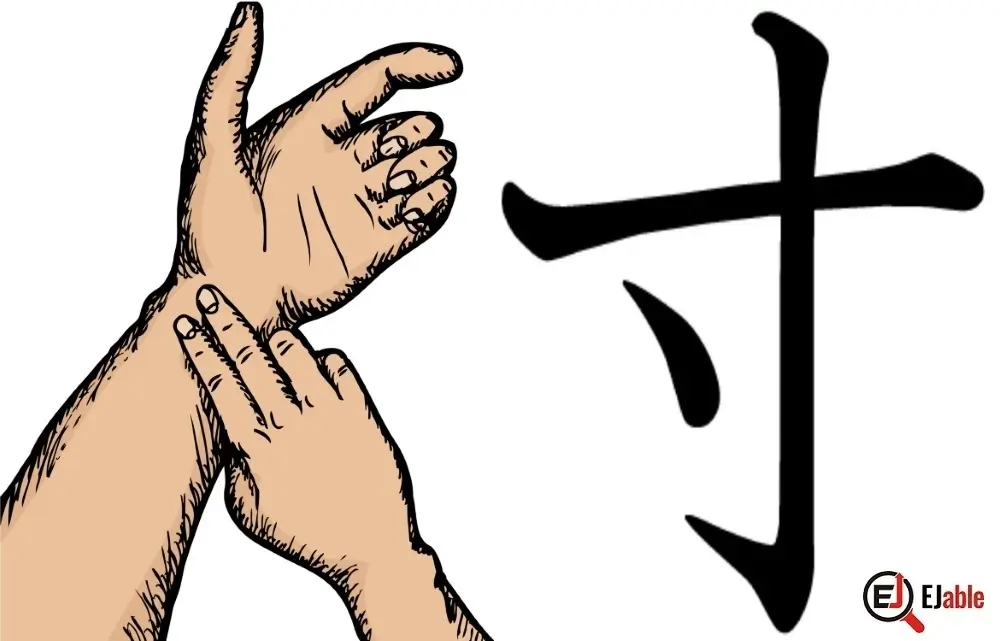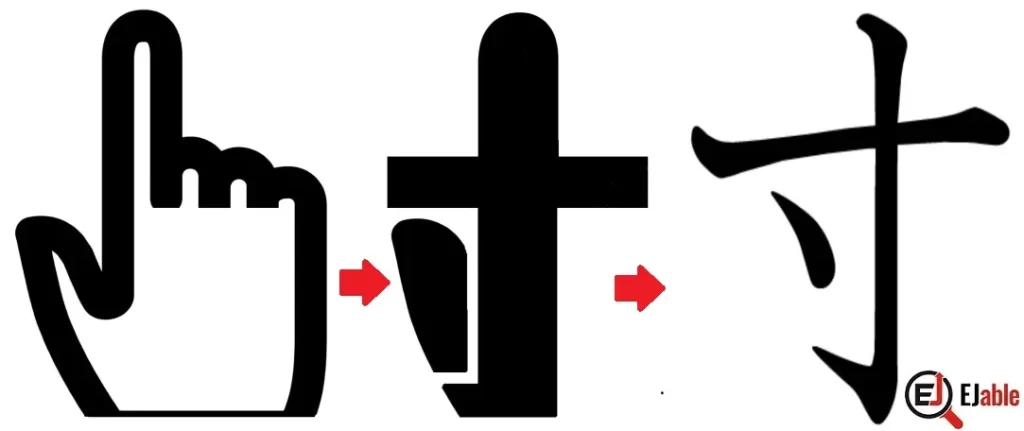Kanji for Shortness, Briefness, and Unit of Measurement: 寸 (Sun, すん)

寸 is the Kanji, which means shortness or tininess. The onyomi or Chinese pronunciation of 寸 is すん (sun). This Kanji does not have kunyomi, or Japanese reading; however, in Japanese names (nanori reading), it is pronounced as す (su) or みき (miki).
The Kanji 寸, which is part of JLPT N1 and taught in the 6th grade in Japanese schools, denotes slightly, for a moment, “a little”, or “a bit of”.
Though not commonly used as a unit of measurement now, 寸 is traditionally defined as a unit of length equivalent to approximately 3.03 cm or about 1.2 inches.
Construction and Origin of Kanji 寸 for Smallness or Briefness
The Kanji 寸, meaning smallness (shortness) or briefness, is constructed with 3 strokes.
This kanji originated as a pictogram representing the width of a thumb at the base of the nail, which was used as a measure of length in ancient China. However, the old shape of this Kanji shows it to be a finger pointing toward the wrist of another hand, as illustrated in the picture below:

In either case, as this Kanji relates to hand, it carries the meaning of a hand in many compounded words.
Mnemonic: How to Remember the Kanji 寸 for Smallness or Tininess
As the current shape of the Kanji 寸 makes it difficult to imagine it to be related to the hand, consider it as the index finger of the hand to indicate the size of a small object:

Other Usage of the Kanji 寸
- Use in Measurements: While it’s no longer commonly used as a unit of measurement in modern Japan, the concept of 寸 is still found in traditional crafts, such as carpentry and tailoring, as well as in traditional medicine, particularly in acupuncture, where body parts are measured in 寸.
- Symbolic and Idiomatic Usage: In addition to its literal meaning, 寸 is used symbolically in various expressions and idioms. For example, 寸前 (すんぜん / sunzen) means “just before,” and 寸断 (すんだん / sundan) means “cutting off abruptly.”
- Calligraphy and Typography: In the art of calligraphy and typography, 寸 plays a role in the composition and balance of characters, as the size and proportion of strokes are often considered in relation to 寸.
寸 As a Radical
The Kanji 寸 (sun) is used as a radical in various other Kanji characters. When 寸 appears as a radical, it often contributes to the meaning related to measurement, smallness, or something related to an aspect of measurement. 寸 appears as a radical or subcomponent in 220 Kanji characters, including 47 Jōyō Kanji.
The following are examples of Kanji characters that include the 寸 radical and their meanings:
- 専 (せん / sen): Specialize, exclusive.
- 射 (しゃ / sha): Shoot, emit.
- 尊 (そん / son): Revered, noble.
- 尋 (じん / jin): Inquire, fathom.
- 導 (どう / dō): Guide, lead.
- 寺 (てら / tera, じ / ji): Temple.
- 時 (じ / ji): Time
- 付 (つ-く / tsu-ku, つ-ける / tsu-keru): Attach, Add to
- 守 (まも-る / mamo-ru, も-り / mo-ri): Protect, Guard
- 討 (う-つ / u-tsu): Attack, Defeat
- 封 (ふう / fū): Seal, enclose.
- 対 (たい / tai): Opposite, against.
- 尉 (い / i): Military officer.
- 寿 (ことぶき / kotobuki): Longevity, congratulations.
- 尋 (たず / tazu): Inquire (another reading).
Compound Words with the Kanji 寸
The Kanji 寸 commonly appears in many compounded characters, generally denoting a small measurement or implying a concept of smallness. There are 40 Japanese words that begin with the Kanji 寸, and it appears in 81 words
Following are the examples of such compound words with their meanings:
- 一寸 (いっすん / issun): One sun (about 3.03 cm).
- 寸前 (すんぜん / sunzen): Just before, on the verge of.
- 寸法 (すんぽう / sunpō): Measurement, dimensions.
- 寸断 (すんだん / sundan): Cutting off abruptly.
- 寸評 (すんぴょう / sunpyō): Brief comment.
- 寸劇 (すんげき / sungeki): Skit, short play.
- 寸暇 (すんか / sunka): Spare moment.
- 寸借 (すんしゃく / sunshaku): A small loan.
- 寸見 (すんけん / sunken): Brief look.
- 寸感 (すんかん / sunkan): Fleeting feeling.
- 寸時 (すんじ / sunji): Brief time, moment.
- 寸心 (すんしん / sunshin): Slight intention.
- 寸鉄 (すんてつ / suntetsu): Small iron rod.
- 寸八 (すんぱち / sunpachi): Small wood strip, narrow piece.
- 寸評 (すんひょう / sunhyō): Brief review.
Conclusion
In conclusion, the Kanji 寸 offers a fascinating glimpse into the intricacies of the Japanese writing system and the cultural importance of traditional measurements.
Originating as a representation of a small yet significant unit of length, 寸 has transcended its original meaning to find a place in modern Japanese, symbolizing smallness or briefness in various contexts.
Its presence as a radical in other characters, most notably in 時 (time), illustrates how 寸 contributes to the formation of complex ideas and concepts, blending the physical with the abstract. The exploration of 寸 thus not only enriches our understanding of a single Kanji character but also opens a window into the historical and cultural dimensions of measurement and scale in Japanese culture.
Check other Kanji characters on the page “How to Remember Kanji“. You may also like to read about the common Kanji radicals.

A long-term ex-pat in Japan, Himanshu comes with an IT background in SAP consulting, IT Business Development, and then running the country operations of an IT consulting multinational. Himanshu is the co-founder and Managing Director of ReachExt K.K. and EJable.com. He is also an Advisory Board Member of a Silicon Valley AI/IoT startup.
